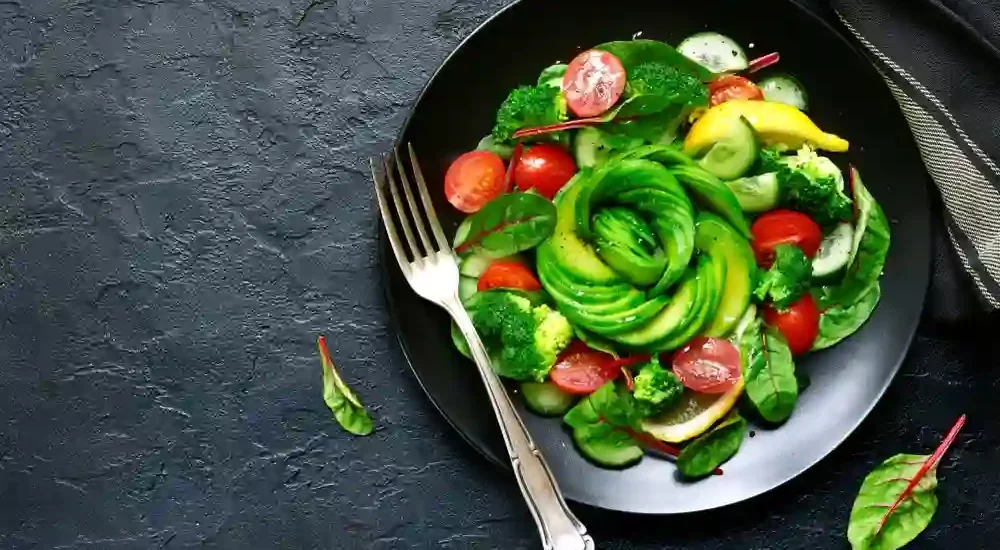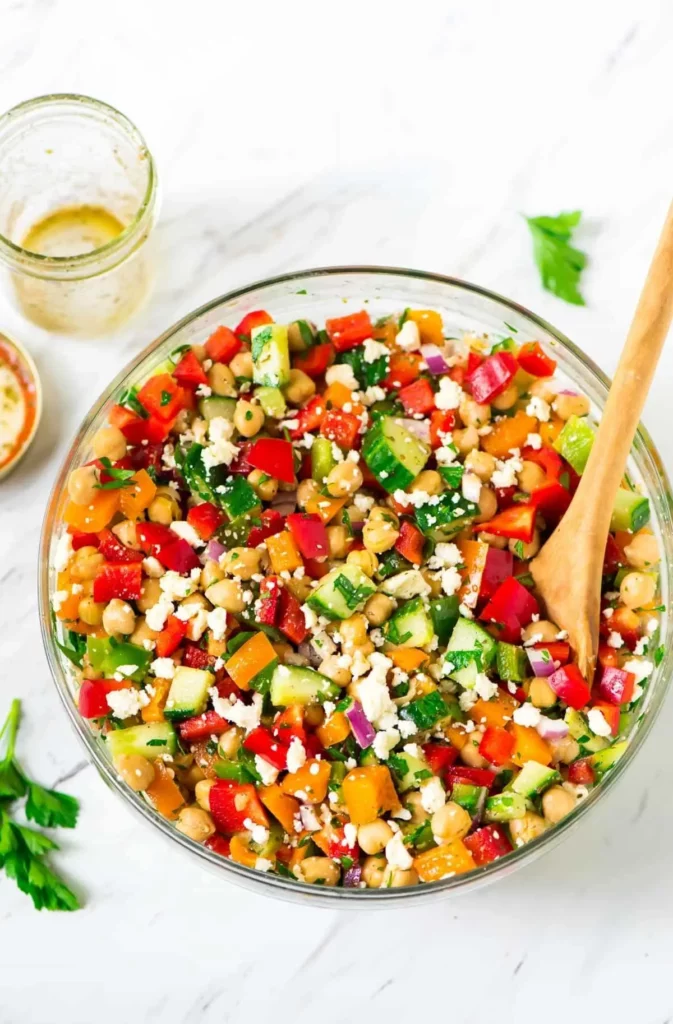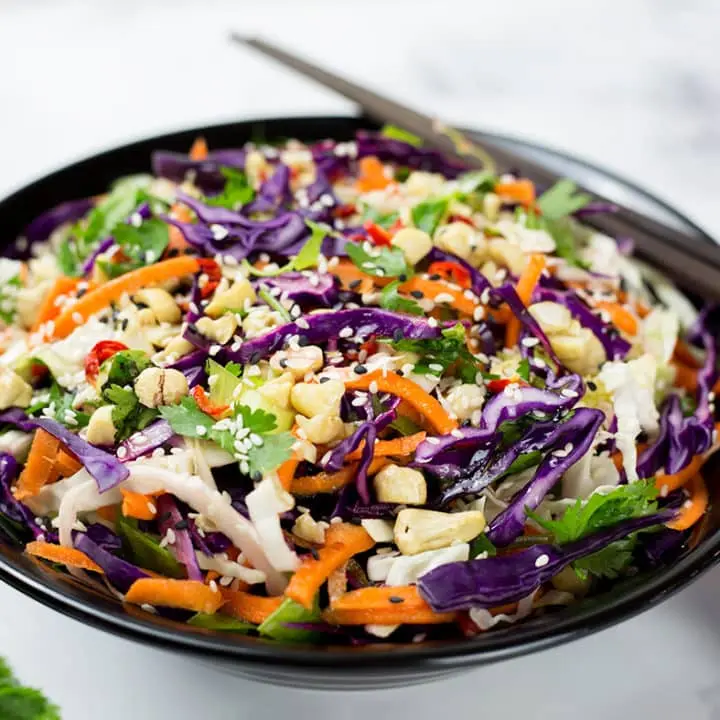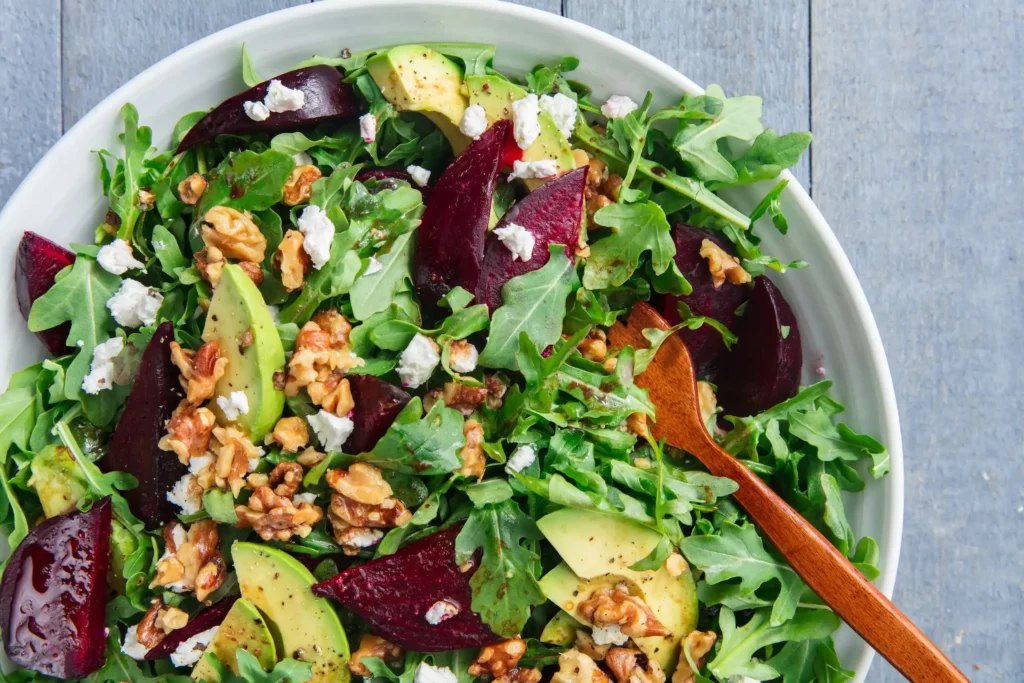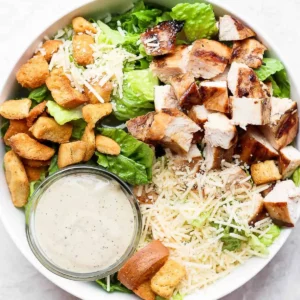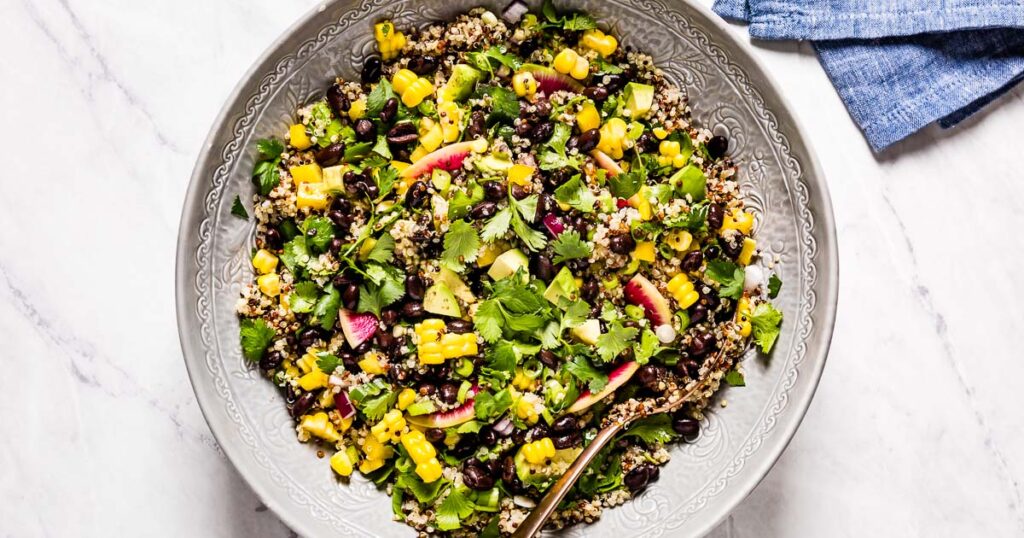Weight loss is the most common activity found in the young generation. People are adopting different ways for losing weight. One of the most common method people use to lose their weight is a weight-loss diet plan. Weight-loss salads are also an important part of the weight loss diet plan. Salads are an essential component of a weight loss journey due to their numerous benefits. Not only they are delicious and refreshing, but they also offer a plethora of advantages for individuals aiming to lose weight. As a low-calorie and nutrient-dense meal option, salads can help promote weight loss while providing essential vitamins, minerals, and fiber. Furthermore, the beauty of salads lies in their versatility, allowing customization to accommodate personal preferences and dietary requirements.
Fundamental of a Weight Loss Salads:
When it comes to weight loss, salads can be your best friend. Packed with vitamins, minerals, fiber, and hydration, salads are not only nutritious but also low in calories. However, not all salads are created equal in terms of weight loss benefits. In this article, we will explore the fundamentals of a weight loss salad, including what makes it suitable for your goals, the importance of nutrient-dense ingredients, and tips for portion control and mindful eating.
What is a Weight Loss Salad?
When it comes to weight loss, salads can be your best friend. Packed with vitamins, minerals, fiber, and hydration, salads are not only nutritious but also low in calories. However, not all salads are created equal in terms of weight loss benefits. In this section, we will explore the fundamentals of a weight loss salad, including what makes it suitable for your goals, the importance of nutrient-dense ingredients, and tips for portion control and mindful eating.
Benefits of Salads for Weight Loss:
- Low-Calorie Option: Salads are typically low in calories, making them an ideal choice for those aiming to create a calorie deficit for weight loss. Incorporating nutrient-packed vegetables as the base of the salad ensures that you can enjoy a substantial portion without excessive calorie intake.
- Nutrient-Dense: Salads offer a wealth of essential nutrients, including vitamins, minerals, and antioxidants. By including a variety of colorful vegetables and leafy greens, you can ensure that your body receives a broad spectrum of beneficial compounds that support overall health and weight loss.
- High in Fiber: Fiber plays a crucial role in weight management by promoting feelings of fullness and satiety. Salads, especially those containing fiber-rich ingredients like vegetables, fruits, and whole grains, help regulate appetite, reduce cravings, and prevent overeating.
- Customizable to Personal Preferences: One of the most significant advantages of salads is their versatility. You have the freedom to choose ingredients based on personal preferences, dietary restrictions, or specific weight loss goals. Whether you prefer a leafy green base or a grain-based salad, you can tailor it to suit your taste and needs.
- Variety and Flavor: Salads can be an exciting and flavorful addition to any weight loss plan. By incorporating a diverse range of vegetables, lean proteins, healthy fats, and herbs or spices, you can create an array of delicious combinations that keep your taste buds satisfied while supporting your weight loss goals.
- Increased Vegetable Intake: Many people struggle to consume an adequate amount of vegetables in their daily diet. Salads provide an excellent opportunity to increase vegetable intake effortlessly. By including a generous portion of vegetables in each salad, you can maximize the nutrient content while keeping the calorie count low.
Key Components of a Well-Balanced Weight-Loss Salad:
A well-balanced weight-loss salad consists of various components that contribute to its nutritional value and satiety. Here are the key elements to consider:
- Vegetables: The foundation of any salad should be a variety of vegetables. Choose an assortment of leafy greens such as spinach, kale, or mixed greens, as they are low in calories and high in fiber, vitamins, and minerals. Additionally, include colorful vegetables like tomatoes, cucumbers, bell peppers, carrots, and radishes to enhance the nutritional profile and add visual appeal.
- Lean Proteins: Adding lean proteins to your salad helps keep you feeling full and satisfied. Opt for grilled chicken breast, turkey, tofu, beans, legumes, or fish like salmon or tuna. These protein sources provide essential amino acids while keeping the calorie content in check.
- Healthy Fats: Incorporating healthy fats into your salad adds flavor and aids in nutrient absorption. Choose sources like avocado, nuts (such as almonds or walnuts), seeds (such as chia or flax seeds), or a drizzle of extra virgin olive oil. These fats provide monounsaturated and polyunsaturated fats, which support heart health and help you feel satiated.
- Flavorful Dressings: Dressings can make or break a salad. Opt for homemade dressings whenever possible to control the ingredients and reduce added sugars and preservatives. Use vinegar (such as balsamic, apple cider, or red wine vinegar), citrus juice (like lemon or lime), or Greek yogurt as a base. Enhance the flavor with herbs, spices, and healthy condiments like Dijon mustard or tahini.
Portion Control and Mindful Eating:
While salads are often seen as a healthy option, it’s essential to practice portion control and mindful eating to support weight loss. Here are some tips to keep in mind:
- Pay attention to portion sizes: Be mindful of the quantity of ingredients you add to your salad. While vegetables are generally low in calories, other components like proteins, healthy fats, and dressings can contribute to the overall calorie count. Use measuring cups or a food scale if necessary, especially when adding calorie-dense ingredients.
- Be mindful of toppings: Avoid excessive use of high-calorie toppings like croutons, fried tortilla strips, cheese, or sugary dried fruits. While these can add flavor and texture, moderation is key. Consider using smaller amounts or healthier alternatives to keep the calorie content in check.
- Chew slowly and savor the flavors: Eating mindfully allows you to fully enjoy your salad while giving your brain time to register feelings of fullness. Chew each bite thoroughly and take your time to savor the flavors. This practice can help prevent overeating and promote better digestion.
- Listen to your body’s hunger and fullness cues: Pay attention to your body’s signals of hunger and satiety. Stop eating when you feel comfortably satisfied, rather than eating until you are overly full. Remember that it takes some time for your brain to register feelings of fullness, so eat slowly and give yourself time to gauge your hunger levels accurately.
Salad Recipes for Weight Loss (Vegetable-Packed Salads)
Following are some of the best salad recipes for weight loss that are most popular in India, US & Pakistan.
Crisp and Colorful Mediterranean Salad:
Ingredients:
- Mixed greens (spinach, romaine lettuce, arugula)
- Cucumbers, sliced
- Tomatoes, diced
- Kalamata olives, pitted
- Feta cheese, crumbled
- Red onion, thinly sliced
- Lemon juice
- Extra virgin olive oil
- Dried oregano
- Salt and pepper to taste
Instructions:
- In a large bowl, combine the mixed greens, cucumbers, tomatoes, olives, and red onion.
- In a small bowl, whisk together lemon juice, olive oil, dried oregano, salt, and pepper to make the dressing.
- Drizzle the dressing over the salad and toss gently to coat.
- Sprinkle crumbled feta cheese on top.
- Serve immediately and enjoy the vibrant flavors of this Mediterranean salad.
Crunchy Asian-Inspired Coleslaw:
Ingredients:
- Green cabbage, thinly sliced
- Carrots, shredded
- Red bell pepper, thinly sliced
- Green onions, chopped
- Fresh cilantro, chopped
- Sesame seeds
- For the dressing:
- Fresh ginger, grated
- Garlic, minced
- Rice vinegar
- Low-sodium soy sauce
- Sesame oil
- Honey or maple syrup (optional for sweetness)
- Salt and pepper to taste
Instructions:
- In a large bowl, combine the cabbage, carrots, bell pepper, green onions, and cilantro.
- In a separate bowl, whisk together the ginger, garlic, rice vinegar, soy sauce, sesame oil, honey (if using), salt, and pepper to make the dressing.
- Pour the dressing over the coleslaw and toss well to coat.
- Sprinkle sesame seeds on top for added crunch and flavor.
- Let the coleslaw sit for a few minutes to allow the flavors to meld together before serving.
Roasted Beet and Goat Cheese Salad:
Ingredients:
- Roasted beets, sliced
- Arugula or mixed greens
- Goat cheese, crumbled
- Walnuts, chopped
- For the dressing:
- Balsamic vinegar
- Extra virgin olive oil
- Dijon mustard
- Honey (optional for sweetness)
- Salt and pepper to taste
Instructions:
- Arrange the arugula or mixed greens on a serving plate.
- Top with sliced roasted beets.
- Sprinkle crumbled goat cheese and chopped walnuts over the beets.
- In a small bowl, whisk together balsamic vinegar, olive oil, Dijon mustard, honey (if using), salt, and pepper to make the dressing.
- Drizzle the dressing over the salad just before serving.
- Enjoy the combination of earthy beets, creamy goat cheese, and crunchy walnuts in this flavorful salad.
Healthy Indian Salad Recipes for Weight Loss (Protein-Rich Salads)
Grilled Chicken Caesar Salad:
Ingredients:
- Romaine lettuce, chopped
- Grilled chicken breast, sliced
- Parmesan cheese, grated
- Whole wheat croutons
- For the dressing:
- Greek yogurt
- Lemon juice
- Garlic, minced
- Dijon mustard
- Worcestershire sauce
- Salt and pepper to taste
Instructions:
- In a large bowl, combine the chopped romaine lettuce, grilled chicken breast slices, and whole wheat croutons.
- In a separate bowl, whisk together Greek yogurt, lemon juice, minced garlic, Dijon mustard, Worcestershire sauce, salt, and pepper to make the dressing.
- Drizzle the dressing over the salad and toss gently to coat.
- Sprinkle grated Parmesan cheese on top.
- Serve immediately and enjoy the protein-packed deliciousness of this grilled chicken Caesar salad.
Quinoa and Black Bean Salad:
Ingredients:
- Cooked quinoa
- Black beans, rinsed and drained
- Avocado, diced
- Corn kernels
- Cherry tomatoes, halved
- Fresh cilantro, chopped
- For the dressing:
- Lime juice
- Olive oil
- Garlic, minced
- Cumin
- Salt and pepper to taste
Instructions:
- In a large bowl, combine the cooked quinoa, black beans, diced avocado, corn kernels, cherry tomatoes, and chopped cilantro.
- In a separate bowl, whisk together lime juice, olive oil, minced garlic, cumin, salt, and pepper to make the dressing.
- Drizzle the dressing over the salad and toss well to coat.
- Refrigerate the salad for a few hours to allow the flavors to meld together.
- Serve chilled and enjoy the protein-rich goodness of this quinoa and black bean salad.
Read Also: Quinoa Recipes For Weight Loss
Tips for Meal-Prepping Salads:
Meal prepping salads can be a game-changer for individuals on a weight loss journey. It saves time, ensures you have healthy options readily available, and helps maintain portion control.
- Choose the Right Storage Containers: Invest in high-quality storage containers that are airtight and leak-proof. Mason jars, glass containers with locking lids, or compartmentalized meal prep containers work well for salads. These containers help maintain the freshness and prevent the ingredients from getting soggy.
- Layer Ingredients Strategically: To keep your salad fresh and prevent it from becoming soggy, it’s essential to layer the ingredients strategically. Start with the dressing at the bottom of the container to avoid the greens getting wilted. Next, add sturdier ingredients like diced vegetables, proteins, and grains. Finally, place delicate ingredients like leafy greens or herbs on top. This layering technique keeps the ingredients separate until ready to eat.
- Pre-Wash and Prep Ingredients: Washing, chopping, and prepping the ingredients ahead of time will save you effort during the week. Wash and dry your greens thoroughly, slice and dice vegetables, cook proteins like chicken or tofu, and portion out grains like quinoa or brown rice. Having everything ready to go will make assembling your salads quick and convenient.
- Keep Ingredients Separate: If you’re prepping salads for multiple days, store certain ingredients separately to maintain their freshness. For example, keep dressing in a separate container or portion it out into individual dressing containers. You can also pack items like nuts, seeds, or croutons in small snack-sized bags to add crunch to your salads just before eating.
- Store Properly: To keep your salads fresh and crisp, store them in the refrigerator. Make sure the containers are sealed tightly to prevent air and moisture from entering. It’s best to consume prepped salads within 3-4 days for optimal freshness and food safety.
Salads-Making Mistakes to Avoid for Weight Loss:
Excessive Use of High-Calorie Toppings and Dressings:
One common mistake when making salads is going overboard with high-calorie toppings and dressings, which can sabotage weight loss efforts. While toppings like croutons, cheese, bacon, or sugary dried fruits can add flavor and texture, they can also significantly increase the calorie content of your salad. The same applies to creamy dressings that are often high in fat and calories.
To avoid this pitfall:
- Use high-calorie toppings sparingly or choose healthier alternatives. For example, replace croutons with toasted whole-grain bread cubes or opt for a small amount of low-fat cheese.
- Prepare your own dressings using healthier ingredients like Greek yogurt, herbs, vinegar, and minimal oil. This way, you can control the portion size and avoid excessive calories and hidden additives.
Neglecting Portion Control and Overeating:
Salads, despite being healthy, can still lead to weight gain if portion control is overlooked. Overloading your plate with large quantities of salad ingredients can easily lead to consuming more calories than intended.
To maintain portion control and prevent overeating:
- Use measuring cups or a food scale to portion out ingredients, especially calorie-dense components like proteins, fats, and dressings.
- Fill the majority of your plate with non-starchy vegetables, like leafy greens and other salad vegetables, while keeping the portion sizes of higher-calorie ingredients in check.
- Eat slowly and mindfully, paying attention to your body’s signals of hunger and fullness. Stop eating when you feel comfortably satisfied, rather than overly full.
Salads: Things to Remember
- Salad can be eaten as an appetiser or as the meal itself if you still get enough calories, nutrients, and protein.
- You can eat a salad at any time of the day. However, you should eat it during the day. That is because raw foods take more time and energy to digest properly. Also, don’t sleep immediately after eating.
- Avoid using store-bought salad dressings since they’re generally full of sugar and salt but low in nutrients. Instead, it’s recommended to make your own salad dressings.
- Keep in mind that salad dressings should be light and simple. Stick to olive oil, vinegar or lemon juice-focused dressings. Avoid heavier condiments like mayonnaise and such since they have a higher fat content.
- Avoid fatty meats and fried foods in your salad since they add unnecessary fat and salt.
- Using dried fruit as a salad ingredient is alright if it’s not the sweetened variety.
- Don’t include refined grains like croutons or crackers in your salad, since they don’t contain valuable vitamins or minerals.
Final Thoughts
Salads play a crucial role in weight loss journeys as they are low in calories yet packed with essential nutrients. Incorporating a variety of vegetables, lean proteins, healthy fats, and flavorful dressings into salads ensures a well-balanced and satisfying meal. Portion control and mindful eating are vital when enjoying salads to prevent overeating. Avoiding common pitfalls such as excessive high-calorie toppings and dressings, neglecting portion control, and relying solely on pre-packaged salads is important for successful weight loss. By following proper storage techniques, preparing and portioning ingredients ahead of time, and using convenient containers, meal-prepping salads becomes an efficient way to stay on track with your weight loss goals. Including vegetable-packed and protein-rich salad options in your meal plans adds variety, flavor, and satiety to your diet while supporting your weight loss journey.
Frequently Asked Questions (FAQs)
Q. Which salad is best for weight loss?
A. A spinach and cabbage salad are best for weight loss.
Q. Can you lose weight by eating salad every day?
A. Replace heavy, high-calorie meals with low-calorie, nutritious salads. However, it must contain enough protein, and then you will end up losing weight and not being nutrient deficient.
Q. Can we eat salad at night for weight loss?
A. Since raw food takes more time and energy to be digested by the body, it’s best to consume salads during the day.
Q. What fruit is best for weight loss?
A. Grapefruits are the best fruits for weight loss.
Q. How can I lose tummy fat fast?
A. Quick ways to lose tummy fat are generally unhealthy and problematic for your body. To lose tummy fat healthily, you have to exercise regularly and eat healthy foods.
Q. Which fruits should be avoided for weight loss?
A. Lychees and Mangoes are high in calories and natural sugars. If you’re on a weight loss journey, it would be best to avoid these fruits.
Q. Will eating salad reduce tummy fats?
A. Salads can help you lose weight and burn fat to a certain extent. However, noticeable change only happens when you combine this diet with exercise.
Q. Is cucumber good for weight loss?
A. Yes, cucumbers are good for weight loss since they’re low in calories. In addition, they’re high in nutrients and water content.
Q. Is Apple good for weight loss?
A. Yes, apples are good for weight loss.
Related


